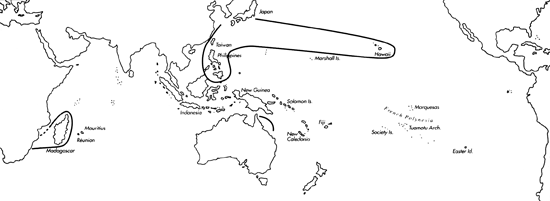Range: Hawaii, Japan to Philippines, and Queensland; Natal and probably Madagascar.
Description: Small to medium-sized, light to moderately solid. Last whorl conical to ventricosely conical; outline straight to slightly convex, concave on left side near base. Shoulder carinate, often slightly undulate. Spire of moderate height to high, stepped; outline concave, occasionally straight. Larval shell of 3.25-3.5 whorls, maximum diameter 0.9-1.1mm. First 4-8 postnuclear whorls tuberculate. Teleoconch sutural ramps flat to concave, with arcuate radial threads and often obselete spiral striae; sometimes with 0-1 increasing to 2-5 weak spiral grooves, distinct in Hawaiian shells, Last whorl usually with axially striate spiral grooves separated by narrow ribbons and ribs from base to shoulder.
| Shell Morphometry | ||
|---|---|---|
| L | 21-38 mm | |
| RW | 0.03-0.12 g/mm | |
| RD | 0.59-0.70 | |
| PMD | 0.80-0.94 | |
| RSH | 0.17-0.26 | |
Ground colour white, sometimes suffused with violet. Last whorl variably encircled with irregular rows of brown dots or dashes. Brown markings clustering or fusing into 2 spiral bands, at centre and near base; occasionally a third, interrupted band below shoulder. Larval whorls usually white. Early postnuclear sutural ramps with widely and regularly spaced brown dots at outer margin. Late ramps with sparse brown radial blotches; marginal dots irregularly set to absent. Aperture translucent, white or light violet.
Periostracum grey to brown, translucent. Periostracum of specimens described as C. lapulapui yellowish grey and finely axially ridged on last whorl, and opaque with strong radial ridges on the sutural ramps.
Habitat and Habits: In 35-500 m.
Discussion: C. eugrammatus and C. wakayamaensis are extremely similar. We distinguish them primarily by colour pattern. C. wakayamaensis generally has more numerous and larger brown pigmented areas. Its spire has many irregular brown radial markings, and it lacks the widely and regularly spaced brown dots on the early postnuclear sutural ramps characteristic of C. eugrammatus. On the last whorl, C. wakayamaensis usually has 3 solid or interrupted brown spiral bands, while C. eugrammatus has 2-3 less regular and often less prominent bands. In addition, the spiral grooves on the last whorl are usually separated by broader ribbons in C. wakayamaensis. C. memiae is also very similar to C. eugrammatus, but it is smaller (to 32 mm) and its last whorl is often slightly pyriform. C. memiae usually has strong spiral grooves on the late sutural ramps, and its colour pattern is more complex, with narrower white spiral bands and spiral rows of brown dots and dashes often fusing into axial streaks and flecks. Shells described as C. lapulapui tend to be smaller (Pl. 53, Fig. 26), but are so similar in all other conchological characters to C. eugrammatus that we consider them to be conspecific.

C. eugrammatus range map
This section contains verbatim reproductions of the accounts of 316 species of Conus from the Indo-Pacific region, from Manual of the Living Conidae, by Röckel, Korn and Kohn (1995). They are reproduced with the kind permission of the present publisher, Conchbooks.
All plates and figures referred to in the text are also in Röckel, Korn & Kohn, 1995. Manual of the Living Conidae Vol. 1: Indo-Pacific Region.
The range maps have been modified so that each species account has it own map, rather than one map that showed the ranges of several species in the original work. This was necessary because each species account is on a separate page on the website and not confined to the order of accounts in the book.